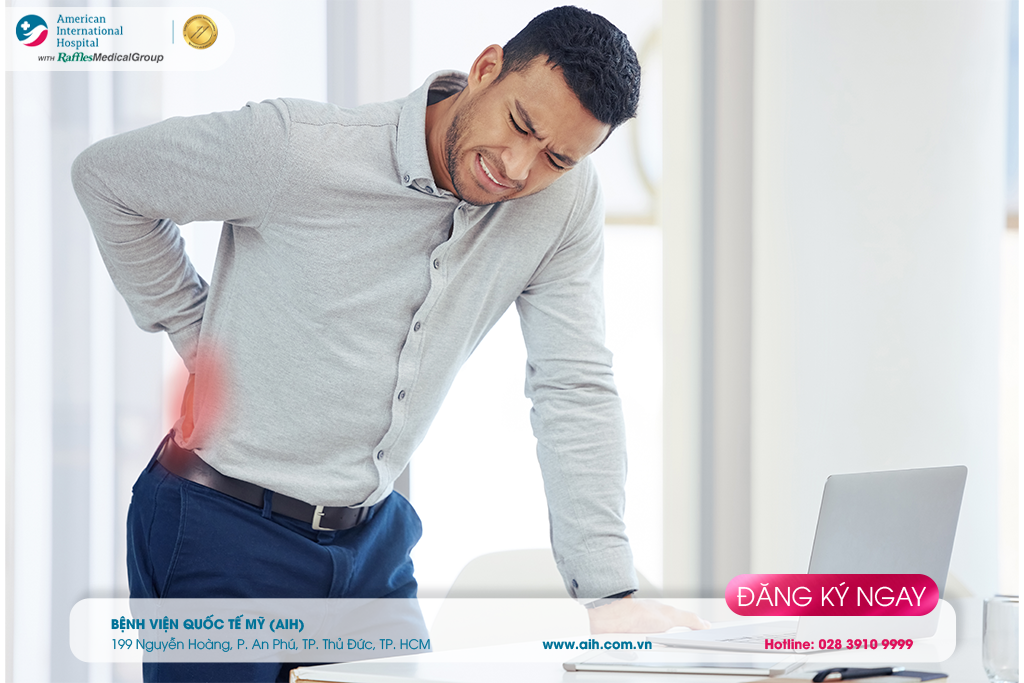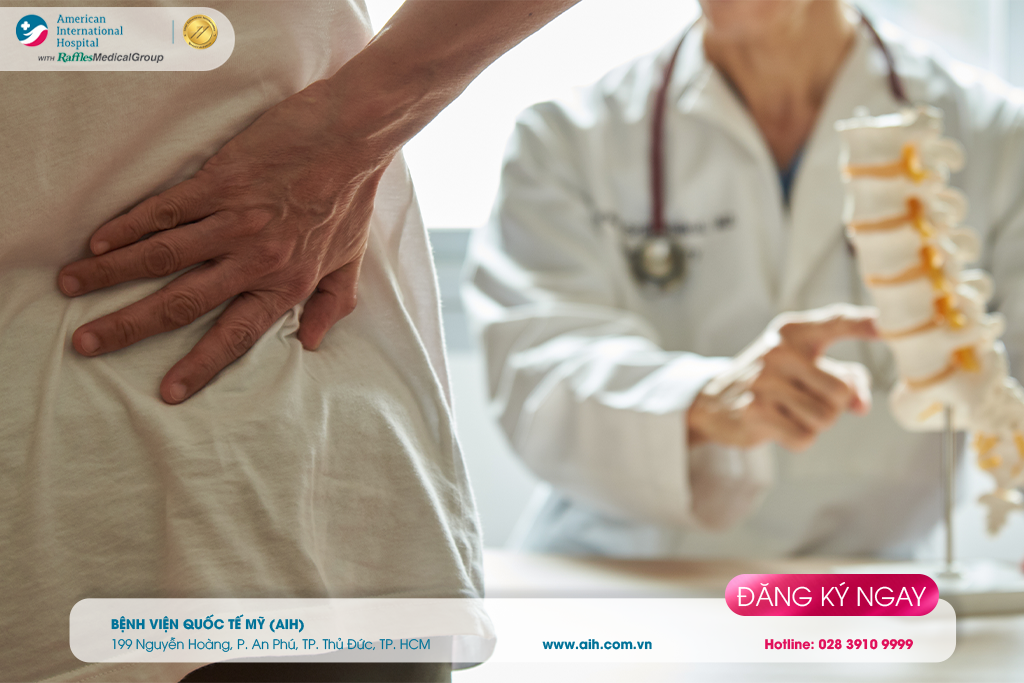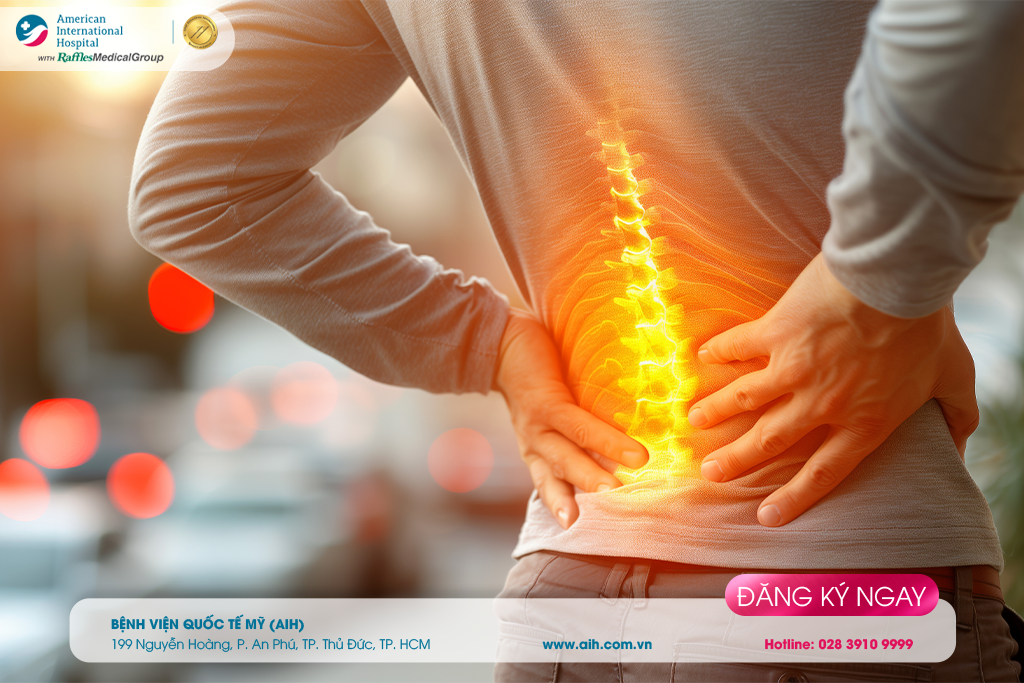Đặt lịch khám
Ngày
Chọn ngày thăm khám
Chuyên khoa
Chọn chuyên khoa bạn muốn thăm khám trong danh sách bên dưới
Bác sĩ
Hãy tham khảo thông tin từ danh sách bên dưới để chọn bác sĩ phù hợp
Giờ
Chọn thời gian thăm khám
Điện thoại
Vui lòng nhập số điện thoại di động để nhận sự hỗ trợ tốt nhất
Thông báo
Vui lòng điền vào thông tin bên dưới
*
*
*
*
*
*
Khẩn cấp
LOWER BACK PAIN – WHAT TO DO TO KEEP YOUR SPINE HEALTHY
The lumbar region (or lower back) is the area that starts from below the rib cage to the hip region. Lower back pain is a common condition and can occur at any age. Except for some cases, most lower back pain is not dangerous; however, it still significantly affects the quality of life if not treated promptly.
How does lower back pain occur?
Lower back pain can be caused by a variety of injuries, conditions, or diseases, most commonly by an injury to a muscle or tendon in the back.
Pain levels can range from mild to severe. In some cases, the pain can make it difficult to walk, sleep, work, or do daily activities.
Typically, mild lower back pain improves with rest, pain medication, and physical therapy exercises. Cortisone injections and manual treatments (such as joint or spinal manipulation) can help relieve pain and aid recovery. If the injury or pain is more severe, the patient will need surgical treatment.
Who is often affected by lower back pain?

How does lower back pain occur?
Lower back pain can be caused by a variety of injuries, conditions, or diseases, most commonly by an injury to a muscle or tendon in the back.
Pain levels can range from mild to severe. In some cases, the pain can make it difficult to walk, sleep, work, or do daily activities.
Typically, mild lower back pain improves with rest, pain medication, and physical therapy exercises. Cortisone injections and manual treatments (such as joint or spinal manipulation) can help relieve pain and aid recovery. If the injury or pain is more severe, the patient will need surgical treatment.
Who is often affected by lower back pain?

- People over 30: Over the age of 30, the discs will wear out and gradually reduce their ability to withstand pressure from the vertebrae. This natural aging process results in increasing pain levels with age.
- Obese people, uncontrolled weight gain: People who are overweight, obese are more likely to experience lower back pain due to excess weight putting pressure on the joints and discs.
- Pregnant women: During pregnancy, body weight increases rapidly and the pelvis needs to adjust to the growing fetus, resulting in hip and back pain.
- People with unhealthy lifestyles: Less exercise leads to weak abdominal muscles that cannot support the spine, sometimes causing strain, even back sprain. People who smoke, or consume alcohol excessively are also at higher risk of back pain.
- Some certain occupations: Jobs and activities that require heavy lifting or bending may increase the risk of back injury. White-collar workers who sit too long or in improper position are also at high risk for chronic lower back pain.
- Young children carrying heavy backpacks: Children who frequently carry heavy backpacks are highly likely to develop scoliosis and cause long-term back, shoulder, and neck pain.
- People with a family history of osteoarthritis, chronic back pain are at higher risk of lower back pain than the normal person.
- People with mental health problems: Depression and anxiety can also be the cause of back pain.
Lower back pain can be caused by many causes including:


- Strains and sprains: Strains and sprains in the back are the most common causes of back pain. Muscle strain can occur as a result of coughing, sneezing, turning, or bending. Injuries to muscles, tendons, or ligaments are often caused by lifting something too heavy or in the improper position.
- Osteoporotic vertebral fractures: Over time or because the diet causes osteoporosis that makes bones brittle and fragile, just a slight injury can cause fractures, especially vertebrae, thereby causing back pain.
- Lumbar disc herniation: The intervertebral disc helps reduce pressure between the vertebrae. When damaged, the disc can bulge out of its position in the spine and compress nerves or have a tear that causes a herniated disc. In the elderly, intervertebral discs may degenerate, losing their elasticity and reducing their inherent function.
- Structural problems: Two common conditions that cause lower back pain associated with spinal structures are spinal stenosis and scoliosis. Spinal stenosis occurs when the space inside the spinal canal is narrowed putting pressure on the nerve roots and spinal cord, which can cause severe sciatica and lower back pain. Scoliosis (or curvature of the spine) is an abnormal curvature of the spine that can lead to pain, stiffness, and difficulty moving.
- Arthritis: Osteoarthritis is the most common type of arthritis that causes lower back pain. Besides, ankylosing spondylitis is also a common cause of lower back pain, inflammation and stiffness of the spine.
- Systemic diseases: Lower back pain can also be a symptom of another disease such as spinal tumors, infections, and some types of cancer. People with kidney stones and abdominal aortic aneurysms may also experience lower back pain.
- Spondylolisthesis: This condition causes the vertebrae in the spine to slip out of place. Spondylolisthesis leads to lower back pain, difficulty walking, even paralysis of the legs.
What are the symptoms of lower back pain?

Symptoms of lower back pain may appear suddenly or gradually. The pain may be sharp or dull and spread down the buttocks or along the back of the legs when performing positions that cause back muscles strain (such as bending over) and gradually subside when lying down to rest.
In addition, lower back pain also has some other symptoms such as:
- Stiffness: The patient has difficulty moving or stretching the back, the range of motion decreases. When sitting for a long time, getting up and walking also takes longer.
- Affecting posture: Many people with lower back pain will find it difficult to stand up straight. As a result, patients often have a posture that leans to one side or is hunched over, with the lower back appearing flat instead of curved like that of a healthy person.
- Muscle spasms: Lower back pain caused by uncontrolled muscle spasms causes extreme pain and makes it difficult or impossible for the patient to stand or move.
When is medical intervention needed?
- Pain that spreads to other parts of the body such as the buttocks and legs may be a sign of sciatica. Sciatica is usually caused by a herniated disc.
- If before the pain, the patient had a traffic accident, fall, or other type of injury, it may be a sign of a serious problem such as a fracture.
- Back pain accompanied by a sensation of pins and needles, numbness or weakness may indicate nerve irritation or damage. Especially if the pain persists even after taking over-the-counter painkillers. Neuropathic pain is very dangerous and, if left untreated, can lead to permanent damage or disability.
- The pain is worse in certain locations or during a specific period. This may be a sign of infection, fracture, severe nerve compression, or even cancer.
- Pain accompanied by bowel incontinence or urinary incontinence may be a sign of cauda equina syndrome, in which the nerves in the lower spine are compressed. Although rare, if left untreated, it can cause permanent nerve damage. Patients need surgery to decompress the nerves and restore their function.
- Pain accompanied by fever and failure to respond to over-the-counter treatments may be a sign of a dangerous infection, the doctor will need to identify the cause and administer appropriate medication such as antibiotics in case of infection.
- Back pain with unintentional weight loss is a warning sign of an infection or tumor in the body.
Diagnosis of lower back pain
In case of lower back pain, the doctor will ask for symptoms and a physical examination. In addition, tests required to determine whether a patient has a fracture or other injury may also be ordered:
- X-rays help detect tuberous abnormalities of the bone.
- MRI, CT scans to investigate abnormal use of bones, muscles, tendons and other soft tissues.
- Electromyography (EMG) to examine nerves and muscles, check for nerve damage (may cause tingling or numbness in the legs).
Depending on the cause of the pain, your doctor may also order additional blood tests or urine tests to detect genetic markers of back pain or kidney stones.
Treatments for lower back pain
- Medication: Your doctor may prescribe certain nonsteroidal anti-inflammatory drugs (NSAIDs) or prescription medications to relieve pain, relax muscles, and prevent lumbar spasms.
- Physiotherapy: To relieve pain and increase flexibility, limiting spinal injuries, patients may be guided to perform physiotherapy measures.
- Some alternative treatments: Some cases of back pain, it is possible to relax tense muscles, reduce pain, and restore mobility to stiff joints through manual adjustment methods such as spinal manipulation, chiropractic therapy, or massage therapies.
- Injections: Depending on the cause of your lower back pain, your doctor may prescribe steroid injections to reduce pain and inflammation.
- Surgery: For severe injuries or herniated discs where medical treatment is ineffective, the doctor may consider prescribing surgery to treat lower back pain.
Lower back pain prevention
Lower back pain due to spinal pathology or structural problems is almost impossible to prevent, however the injuries that cause back pain can be prevented by some of the following measures:
- Maintain a healthy weight to reduce pressure on the vertebrae and discs.
- Strengthen your abdominal muscles by Pilates and core strengthening exercises that support your spine.
- Do exercises to support and relieve lower back pain such as: hip flexor stretching, spinal straightening, child’s pose, legs-up-the-wall pose, pelvic tilt exercises.
- When lifting heavy objects, spread your legs, back straight, hold the object close to your abdomen, and stand up slowly to avoid back injuries. Try not to turn your body while lifting.
--------------------
For checkup and consultation at AIH:
☎️ Hotline: (028) 3910 9999
🌏 Website: www.aih.com.vn
📍 Address: (Entrance from 199 Nguyen Hoang Street) No.6, Bac Nam 3 Street, An Phu Ward, Thu Duc City, Ho Chi Minh City.
Tìm kiếm
Tin tức
Bác sĩ









Để lại bình luận